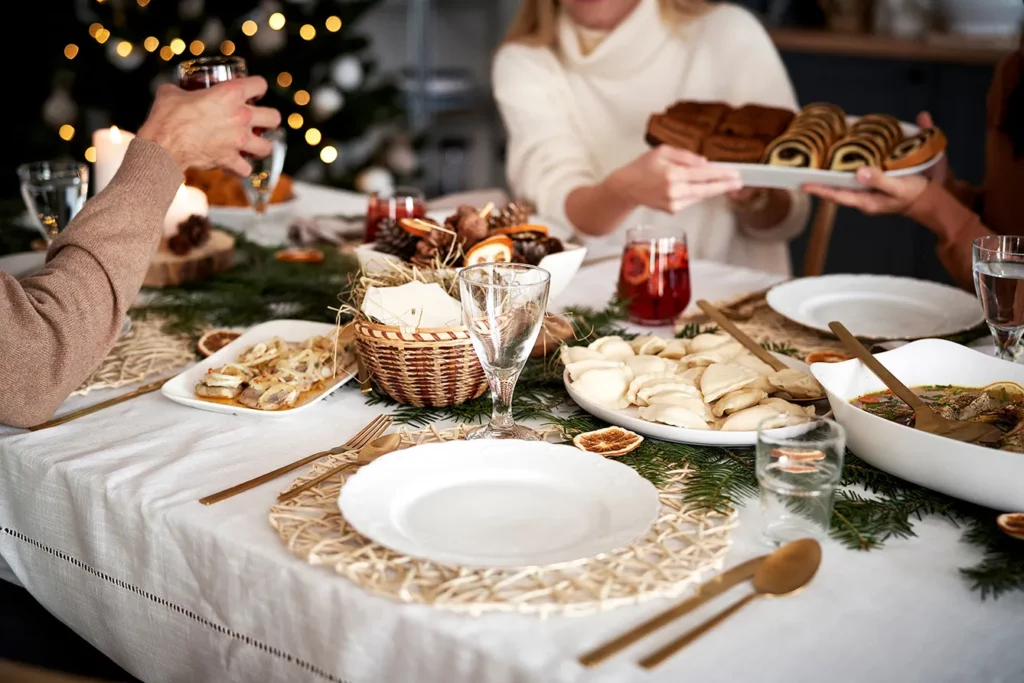In another article, we discussed how and why the Polish Christmas Eve meal is considered one of Europe’s healthiest feasts. But feasting is not everything that goes on in Polish homes on this magical evening. Many foreigners who join Poles on a traditional Christmas Eve sometimes feel a little overwhelmed with the order of items on the day. Fear not, and read on to learn a bit about the reasons behind some of Polish Christmas Eve traditions.
A day of preparations
Firstly, it is good to remember that Poles practice the rite of celebrating the Eve of many holidays, with the evening celebrations being the focal point of the entire festival. Such is the case with Easter and Christmas. During the day, you will see people preparing the last few bits before the first star appears in the dark sky, giving them the green light to sit at the table and begin the celebrations.
Children usually keep their eyes wide open, trying to spot that star. Of course, one of the main benefits of this is that it is a big help to those involved with preparing the table and dishes so that little humans do not get under the grown-up’s feet yet still feel involved in the events. Traditionally, Christmas Eve day is also the moment to decorate the tree. However, you will see many homes moving that particular item to the night before or even a couple of days (weeks) earlier to avoid the mess accompanying tree decoration.
Put hay under the tablecloth
The table is set in a very particular way. The tablecloth must be white, and underneath it, Poles place a little hay. In the past, before the Christmas tree entered the houses, people would put hay on the floor of their homes and make crosses out of hay, which they would place in the corner of their main room. Today, the amount of hay placed under the tablecloth is very symbolic, as is the entire meaning of the tradition. It reminds us that Baby Jesus was brought into this world in a stable and laid down in a manger. It connects us to that humble place and reminds Catholics how God wanted to be born among the poorest and most disadvantaged.
But this tradition also has a theological layer, often overlooked nowadays. The whiteness of the tablecloth is a reminder of the corporal – a piece of white cloth used in the Catholic Church during the mass when the Bread and Wine become the Body and Blood of Christ. You see, the manger has a very theologically significant meaning – it was a sign that Jesus was to become and bring spiritual sustenance to humankind. And so, Poles celebrate by symbolically connecting to that stable where the course of history was changed, bringing Catholics their spiritual nourishment.
Additional seat
Poles can count, and that extra place setting on the table is not a mistake. It actually has two meanings. Firstly, the seat is prepared for a strayed wanderer, who may want to come and join you at the table. Since on this day no one should be left without shelter and food, Poles, in this way, practice the Christian virtue of feeding (and clothing) the poor and disadvantaged, welcoming a stranger in their homes if need be, since they too are loved by God.

But you may also notice how some Poles place a piece of bread they share at the start of the supper (which we will explain in a second) on that empty plate. They do that as the seat also reminds them of all the departed, who are no longer with them in this life, and those loved ones who could not join them in celebrations. That piece of bread is there to share with them – a symbol of undying love and the connection of the souls.
Opłatek – the white, wafer bread
Before sitting down to eat, many Catholic homes will listen to a fragment from the Bible about the birth of Christ. They then will say a prayer and share the white, unleavened bread. It has the same form as the bread consecrated during Catholic mass – a white, thin wafer, traditionally baked with images of saints or the stable with Christ. The custom goes back to the 16th century and is mainly cultivated in Polish homes. The meaning of the name Bethlehem – the town where Jesus was born – stands for “the house of bread,” and hence the gesture of sharing the bread symbolizes spreading love, compassion, and forgiveness with those with whom you share.

Bread, in general, has an important place in Polish symbolism and culture, and the tradition of bread sharing is kept even by those who do not follow the religious ideas from which the custom originated. However, they recognize it as an important gesture of community and rarely skip it. Before the era of text messages and messenger platforms, it was also customary to receive a piece of white bread in letters with wishes from friends and family who lived far away. In fact, it is still practiced by many Poles, but not as widespread as in the past.
In the countryside, farmers would share the bread with their livestock, though the bread for animals was usually baked with a bit of color added to it – different for each animal kind. People still practice this tradition, and many also share a little piece with their family pets. The gesture symbolizes asking for the animals’ protection and health.
An odd number of dishes becomes 12
Then you can sit down to eat. The table is set with 12 dishes, which traditionally symbolize the 12 disciples of Christ (some people mistake it for 12 months of the year). In the past, however, the poorer families could not afford such elaborate dinners, and the number of dishes on the table was also a sign of status. Traditionally, there were an odd number of dishes, and the most affluent families celebrated with 11 or 13 dishes; nobles with 9; townspeople with 7; and paupers with five or less. Before the evening feast, people observe the fast, which may be a clue as to why they had enough room in their stomachs to manage the elaborate pescatarian evening meal.
Carols and presents
With their bellies full, many families still sing Christmas carols together (the meaning of Polish Christmas carols was briefly discussed in another article on our portal). And just as popular as having little Christmas Eve meals with your co-workers, a traditional Polish version of a Christmas party, many people gather in the following weeks until February 2 (the official end of the Christmas season in the Catholic Church) for carol-singing. Presents in Poland are unwrapped on Christmas Eve (the most awaited moment by the family’s youngest members), which usually is the final item on the list, followed by a hefty dose of relaxation and conversations. Catholics will attend the Shepherds’ Mass, traditionally said at midnight – the break of Christmas Day. These days, you can see many Churches holding an additional 10 pm Shepherds Mass aimed at children and older people, who may struggle to stay up to celebrate during the night.
Celebrations continue
Polish celebrations then continue on Christmas Day and Boxing Day, the latter being usually devoted to meeting friends. It is an extraordinary time in Poland that has the power to truly bring everyone together. Culturally an important period in the Polish calendar, it gathers people from all walks of life who put their differences aside and spend the festive days celebrating what unites them – love, compassion, and forgiveness.
If you have an opportunity to join a Polish home during this special time, we hope you will now feel encouraged to do so and won’t get lost in the maze of customs practiced by the majority of Polish households So, as they say in Poland, Wesołych Świąt!







